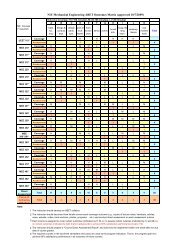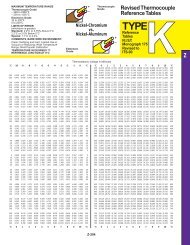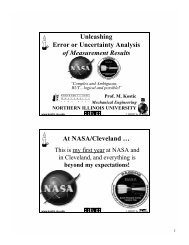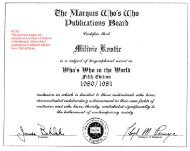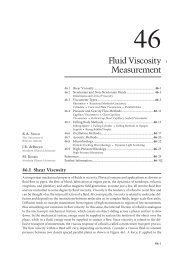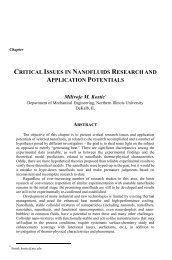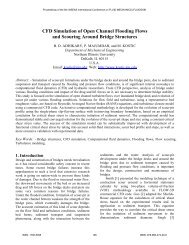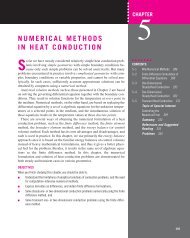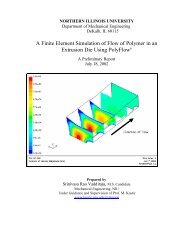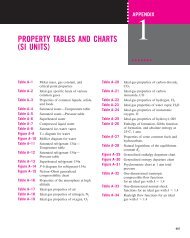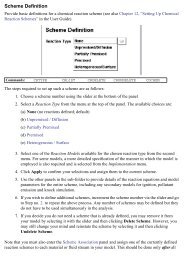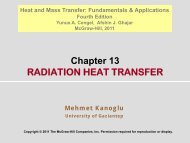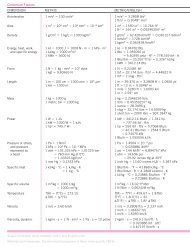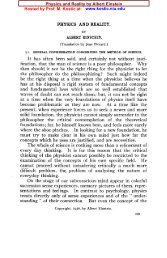Chapter 11 REFRIGERATION CYCLES - Kostic
Chapter 11 REFRIGERATION CYCLES - Kostic
Chapter 11 REFRIGERATION CYCLES - Kostic
Create successful ePaper yourself
Turn your PDF publications into a flip-book with our unique Google optimized e-Paper software.
Thermodynamics: An Engineering Approach, 7 th Edition<br />
Yunus A. Cengel, Michael A. Boles<br />
McGraw-Hill, 20<strong>11</strong>©<br />
<strong>Chapter</strong> <strong>11</strong><br />
<strong>REFRIGERATION</strong> <strong>CYCLES</strong><br />
Mehmet Kanoglu<br />
Copyright © The McGraw-Hill Companies, Inc. Permission required for reproduction or display.
Objectives<br />
• Introduce the concepts of refrigerators and heat pumps<br />
and the measure of their performance.<br />
• Analyze the ideal vapor-compression refrigeration cycle.<br />
• Analyze the actual vapor-compression refrigeration cycle.<br />
• Review the factors involved in selecting the right<br />
refrigerant for an application.<br />
• Discuss the operation of refrigeration and heat pump<br />
systems.<br />
• Evaluate the performance of innovative vaporcompression<br />
refrigeration systems.<br />
• Analyze gas refrigeration systems.<br />
• Introduce the concepts of absorption-refrigeration<br />
systems.<br />
2
REFRIGERATORS<br />
AND HEAT PUMPS<br />
The transfer of heat from a low-temperature<br />
region to a high-temperature one requires<br />
special devices called refrigerators.<br />
Refrigerators and heat pumps are essentially<br />
the same devices; they differ in their<br />
objectives only.<br />
for fixed values of Q L and Q H<br />
The objective of a refrigerator is to remove heat<br />
(Q L ) from the cold medium; the objective of a heat<br />
pump is to supply heat (Q H ) to a warm medium.<br />
3
The reversed Carnot cycle is the most efficient<br />
refrigeration cycle operating between T L and T H .<br />
However, it is not a suitable model for refrigeration<br />
cycles since processes 2-3 and 4-1 are not practical<br />
because<br />
Process 2-3 involves the compression of a liquid–vapor<br />
mixture, which requires a compressor that will handle<br />
two phases, and process 4-1 involves the expansion of<br />
high-moisture-content refrigerant in a turbine.<br />
THE REVERSED<br />
CARNOT CYCLE<br />
Both COPs increase<br />
as the difference<br />
between the two<br />
temperatures<br />
decreases, that is, as<br />
T L rises or T H falls.<br />
Schematic of a<br />
Carnot refrigerator<br />
and T-s diagram<br />
of the reversed<br />
Carnot cycle.<br />
4
THE IDEAL VAPOR-COMPRESSION <strong>REFRIGERATION</strong> CYCLE<br />
The vapor-compression refrigeration cycle is the ideal model for refrigeration<br />
systems. Unlike the reversed Carnot cycle, the refrigerant is vaporized completely<br />
before it is compressed and the turbine is replaced with a throttling device.<br />
This is the<br />
most widely<br />
used cycle for<br />
refrigerators,<br />
A-C systems,<br />
and heat<br />
pumps.<br />
Schematic and T-s diagram for the ideal<br />
vapor-compression refrigeration cycle.<br />
5
The ideal vapor-compression refrigeration cycle involves an irreversible (throttling)<br />
process to make it a more realistic model for the actual systems.<br />
Replacing the expansion valve by a turbine is not practical since the added<br />
benefits cannot justify the added cost and complexity.<br />
Steady-flow<br />
energy balance<br />
An ordinary<br />
household<br />
refrigerator.<br />
The P-h diagram of an ideal vaporcompression<br />
refrigeration cycle.<br />
6
ACTUAL VAPOR-COMPRESSION <strong>REFRIGERATION</strong> CYCLE<br />
An actual vapor-compression refrigeration cycle differs from the ideal one in<br />
several ways, owing mostly to the irreversibilities that occur in various<br />
components, mainly due to fluid friction (causes pressure drops) and heat transfer<br />
to or from the surroundings. The COP decreases as a result of irreversibilities.<br />
DIFFERENCES<br />
Non-isentropic<br />
compression<br />
Superheated vapor<br />
at evaporator exit<br />
Subcooled liquid at<br />
condenser exit<br />
Pressure drops in<br />
condenser and<br />
evaporator<br />
Schematic and T-s diagram for the actual<br />
vapor-compression refrigeration cycle.<br />
7
SELECTING THE RIGHT REFRIGERANT<br />
• Several refrigerants may be used in refrigeration systems such as<br />
chlorofluorocarbons (CFCs), ammonia, hydrocarbons (propane, ethane, ethylene,<br />
etc.), carbon dioxide, air (in the air-conditioning of aircraft), and even water (in<br />
applications above the freezing point).<br />
• R-<strong>11</strong>, R-12, R-22, R-134a, and R-502 account for over 90 percent of the market.<br />
• The industrial and heavy-commercial sectors use ammonia (it is toxic).<br />
• R-<strong>11</strong> is used in large-capacity water chillers serving A-C systems in buildings.<br />
• R-134a (replaced R-12, which damages ozone layer) is used in domestic<br />
refrigerators and freezers, as well as automotive air conditioners.<br />
• R-22 is used in window air conditioners, heat pumps, air conditioners of commercial<br />
buildings, and large industrial refrigeration systems, and offers strong competition<br />
to ammonia.<br />
• R-502 (a blend of R-<strong>11</strong>5 and R-22) is the dominant refrigerant used in commercial<br />
refrigeration systems such as those in supermarkets.<br />
• CFCs allow more ultraviolet radiation into the earth’s atmosphere by destroying the<br />
protective ozone layer and thus contributing to the greenhouse effect that causes<br />
global warming. Fully halogenated CFCs (such as R-<strong>11</strong>, R-12, and R-<strong>11</strong>5) do the<br />
most damage to the ozone layer. Refrigerants that are friendly to the ozone layer<br />
have been developed.<br />
• Two important parameters that need to be considered in the selection of a<br />
refrigerant are the temperatures of the two media (the refrigerated space and the<br />
environment) with which the refrigerant exchanges heat.<br />
8
HEAT PUMP SYSTEMS<br />
A heat pump can be<br />
used to heat a house<br />
in winter and to cool<br />
it in summer.<br />
The most common energy source for<br />
heat pumps is atmospheric air (air-toair<br />
systems).<br />
Water-source systems usually use<br />
well water and ground-source<br />
(geothermal) heat pumps use earth as<br />
the energy source. They typically have<br />
higher COPs but are more complex<br />
and more expensive to install.<br />
Both the capacity and the efficiency of<br />
a heat pump fall significantly at low<br />
temperatures. Therefore, most airsource<br />
heat pumps require a<br />
supplementary heating system such<br />
as electric resistance heaters or a gas<br />
furnace.<br />
Heat pumps are most competitive in<br />
areas that have a large cooling load<br />
during the cooling season and a<br />
relatively small heating load during the<br />
heating season. In these areas, the<br />
heat pump can meet the entire cooling<br />
and heating needs of residential or<br />
commercial buildings.<br />
9
INNOVATIVE VAPOR-COMPRESSION<br />
<strong>REFRIGERATION</strong> SYSTEMS<br />
• The simple vapor-compression refrigeration cycle is the most widely<br />
used refrigeration cycle, and it is adequate for most refrigeration<br />
applications.<br />
• The ordinary vapor-compression refrigeration systems are simple,<br />
inexpensive, reliable, and practically maintenance-free.<br />
• However, for large industrial applications efficiency, not simplicity, is<br />
the major concern.<br />
• Also, for some applications the simple vapor-compression<br />
refrigeration cycle is inadequate and needs to be modified.<br />
• For moderately and very low temperature applications some<br />
innovative refrigeration systems are used. The following cycles will be<br />
discussed:<br />
• Cascade refrigeration systems<br />
• Multistage compression refrigeration systems<br />
• Multipurpose refrigeration systems with a single compressor<br />
• Liquefaction of gases<br />
10
Cascade Refrigeration Systems<br />
Some industrial applications require moderately low temperatures, and the<br />
temperature range they involve may be too large for a single vapor-compression<br />
refrigeration cycle to be practical. The solution is cascading.<br />
Cascading<br />
improves the<br />
COP of a<br />
refrigeration<br />
system.<br />
Some systems<br />
use three or<br />
four stages of<br />
cascading.<br />
A two-stage cascade refrigeration system<br />
with the same refrigerant in both stages.<br />
<strong>11</strong>
Multistage<br />
Compression<br />
Refrigeration Systems<br />
When the fluid used throughout the cascade<br />
refrigeration system is the same, the heat<br />
exchanger between the stages can be replaced<br />
by a mixing chamber (called a flash chamber)<br />
since it has better heat transfer characteristics.<br />
A two-stage compression refrigeration<br />
system with a flash chamber.<br />
12
Multipurpose Refrigeration Systems with a Single<br />
Compressor<br />
Some applications require refrigeration at more than one temperature. A<br />
practical and economical approach is to route all the exit streams from the<br />
evaporators to a single compressor and let it handle the compression process<br />
for the entire system.<br />
Schematic and T-s diagram for a refrigerator–freezer unit with one compressor.<br />
13
Liquefaction of Gases<br />
Many important scientific and engineering processes at cryogenic temperatures (below<br />
about 100°C) depend on liquefied gases including the separation of oxygen and nitrogen<br />
from air, preparation of liquid propellants for rockets, the study of material properties at low<br />
temperatures, and the study of superconductivity.<br />
The storage (i.e., hydrogen) and<br />
transportation of some gases (i.e., natural<br />
gas) are done after they are liquefied at very<br />
low temperatures. Several innovative cycles<br />
are used for the liquefaction of gases.<br />
Linde-Hampson system<br />
for liquefying gases.<br />
14
GAS <strong>REFRIGERATION</strong> <strong>CYCLES</strong><br />
The reversed Brayton cycle (the gas<br />
refrigeration cycle) can be used for<br />
refrigeration.<br />
Simple gas refrigeration cycle.<br />
15
The gas refrigeration cycles have<br />
lower COPs relative to the vaporcompression<br />
refrigeration cycles or<br />
the reversed Carnot cycle.<br />
The reversed Carnot cycle<br />
consumes a fraction of the net work<br />
(area 1A3B) but produces a greater<br />
amount of refrigeration (triangular<br />
area under B1).<br />
An open-cycle aircraft cooling system.<br />
Despite their relatively low COPs, the gas<br />
refrigeration cycles involve simple, lighter<br />
components, which make them suitable<br />
for aircraft cooling, and they can<br />
incorporate regeneration<br />
16
Without regeneration, the lowest turbine inlet temperature is T 0 , the temperature of<br />
the surroundings or any other cooling medium.<br />
With regeneration, the high-pressure gas is further cooled to T 4 before expanding in<br />
the turbine.<br />
Lowering the turbine inlet temperature automatically lowers the turbine exit<br />
temperature, which is the minimum temperature in the cycle.<br />
Extremely low temperatures can be achieved<br />
by repeating regeneration process.<br />
Gas refrigeration cycle with regeneration.<br />
17
ABSORPTION <strong>REFRIGERATION</strong> SYSTEMS<br />
Ammonia absorption refrigeration cycle.<br />
When there is a<br />
source of<br />
inexpensive thermal<br />
energy at a<br />
temperature of 100<br />
to 200°C is<br />
absorption<br />
refrigeration.<br />
Some examples<br />
include geothermal<br />
energy, solar energy,<br />
and waste heat from<br />
cogeneration or<br />
process steam<br />
plants, and even<br />
natural gas when it is<br />
at a relatively low<br />
price.<br />
18
• Absorption refrigeration systems (ARS) involve the absorption of a<br />
refrigerant by a transport medium.<br />
• The most widely used system is the ammonia–water system, where<br />
ammonia (NH 3 ) serves as the refrigerant and water (H 2 O) as the transport<br />
medium.<br />
• Other systems include water–lithium bromide and water–lithium chloride<br />
systems, where water serves as the refrigerant. These systems are limited<br />
to applications such as A-C where the minimum temperature is above the<br />
freezing point of water.<br />
• Compared with vapor-compression systems, ARS have one major<br />
advantage: A liquid is compressed instead of a vapor and as a result the<br />
work input is very small (on the order of one percent of the heat supplied to<br />
the generator) and often neglected in the cycle analysis.<br />
• ARS are often classified as heat-driven systems.<br />
• ARS are much more expensive than the vapor-compression refrigeration<br />
systems. They are more complex and occupy more space, they are much<br />
less efficient thus requiring much larger cooling towers to reject the waste<br />
heat, and they are more difficult to service since they are less common.<br />
• Therefore, ARS should be considered only when the unit cost of thermal<br />
energy is low and is projected to remain low relative to electricity.<br />
• ARS are primarily used in large commercial and industrial installations.<br />
19
The COP of actual absorption<br />
refrigeration systems is usually less<br />
than 1.<br />
Air-conditioning systems based on<br />
absorption refrigeration, called<br />
absorption chillers, perform best<br />
when the heat source can supply<br />
heat at a high temperature with little<br />
temperature drop.<br />
Determining the<br />
maximum COP of<br />
an absorption<br />
refrigeration system.<br />
20
Summary<br />
• Refrigerators and Heat Pumps<br />
• The Reversed Carnot Cycle<br />
• The Ideal Vapor-Compression<br />
Refrigeration Cycle<br />
• Actual Vapor-Compression<br />
Refrigeration Cycle<br />
• Selecting the Right Refrigerant<br />
• Heat Pump Systems<br />
• Innovative Vapor-Compression<br />
Refrigeration Systems<br />
21



